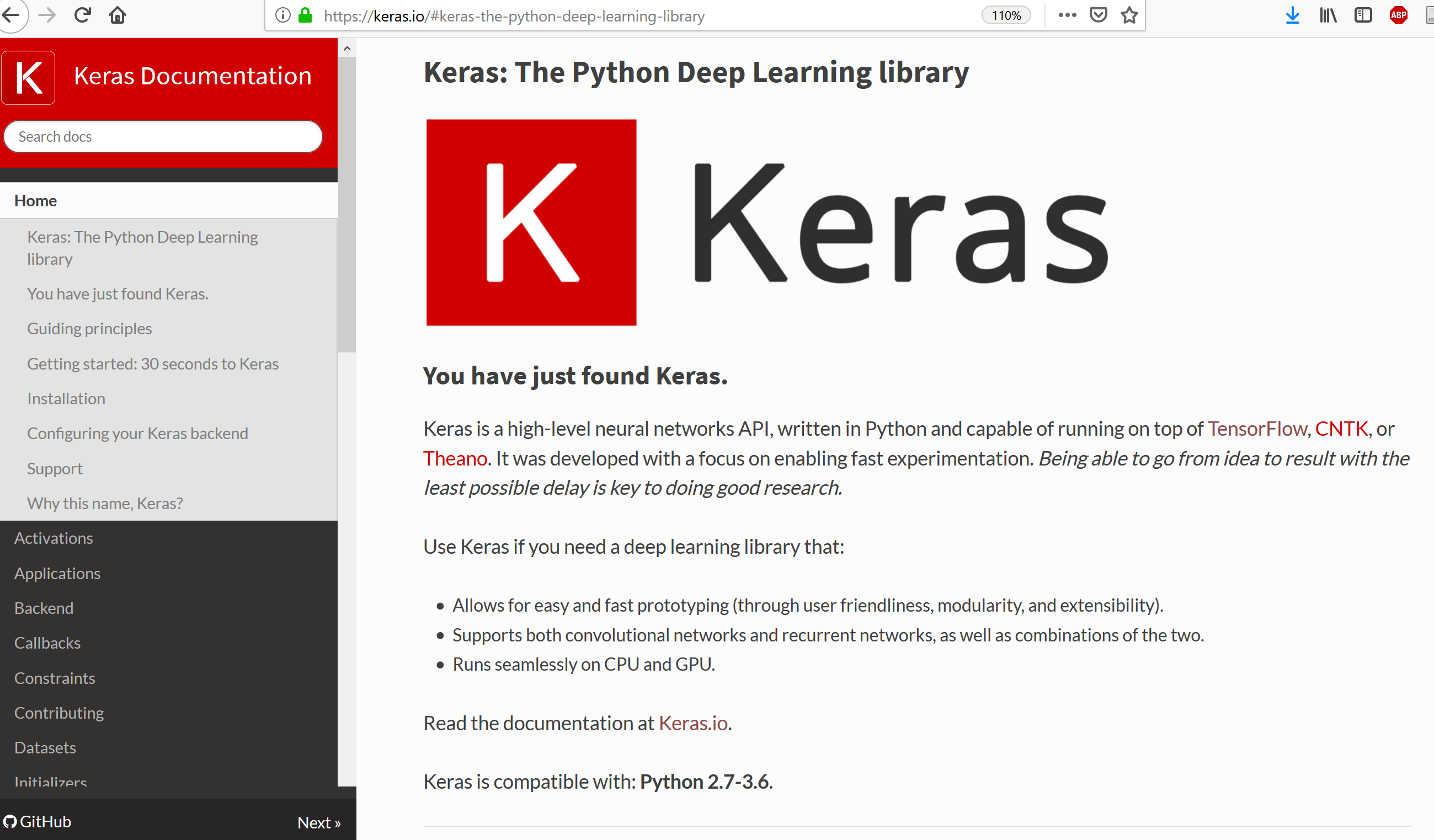Unstructured Data & Natural Language Processing
Topic: Intro to Neural Networks with Keras
Today:¶
- Background: from Language models to machine learning
- Keras
- Keras Demo
- Convolutional Neural Networks
Reading:
- Chollet Chapter 3 (Getting started with neural networks)
- Chollet Chapter 6 (Deep learning for text and sequences)
- Geron, 2e Chapter 10 (Introduction to Artificial Neural Networks with Keras)
- "Text classification with preprocessed text: Movie reviews" https://www.tensorflow.org/tutorials/keras/text_classification
- "Getting Started with TensorFlow and Deep Learning: SciPy 2018 Tutorial", Josh Gordon, https://www.youtube.com/watch?v=tYYVSEHq-io
I. Background¶
Language models¶
"Sequence" model¶
$$P(\text{first word}=\text{"once"},\text{second word}=\text{"upon"},\text{third word}=\text{"a"},\text{fourth word}=\text{"time"})$$"Predictive" model¶
$$P(\text{fourth word}=\text{"time"}\,|\,\text{first word}=\text{"once"},\text{second word}=\text{"upon"},\text{third word}=\text{"a"})$$Different versions of same information. Both are referred to as "language models".
$N$-grams¶
Model order limited to length $N$ sequences:
\begin{align} P(w_n|w_{1}...w_{n-1}) &\approx P(w_n|w_{n-(N-1)}...w_{n-1}) \\ P(w_n|w^{n-1}_1) &\approx P(w_n|w^{n-1}_{n-N+1}) \end{align}- Unigram
- Bigram
- Trigram
Use previous $N-1$ words, relative frequencies of $N$-grams to estimate probabilities.
This is not machine learning, just statistics.
Applications of language models¶
- Spelling/Grammmar checking
- Word completion
- Autoregressive text generation
Word Embeddings¶
- many approaches
- simplest: dimensionality reduction of word-document marix
- reduce dimensions of words from thousands to hundreds
- new reduced dimensions are linear combination over words
Machine Learning: fitting functions (models) to data¶
$\bf x$ - input data ~ a single image, or sentence of text.
$\bf y$ - prediction ~ "cat" vs "dog", "positive" vs "negative"
$f(\cdot)$ - mapping from input to output - function we fit
Formal Machine Learning Framework & Jargon¶
Given training data $(\mathbf x_{(i)},y_i)$ for $i=1,...,m$.
Choose a model $f(\cdot)$ where we want to make $f(\mathbf x_{(i)})\approx y_i$ (for all $i$)
Define a loss function $L(f(\mathbf x), y)$ to minimize by changing $f(\cdot)$ ...by adjusting the weights.
Language model: $P(w_n|w_{1}...w_{n-1}) = f(\mathbf x_{(i)})\approx y_i$, so $w_{1}...w_n$ is $\mathbf x_{(i)}$, and $P \in [0,1]$ is $y$
Naive Bayes Classifier $c = \max_c P(c|w_{1}...w_{n}) = f(\mathbf x_{(i)})\approx y_i$, so $w_{1}...w_{n}$ is $\mathbf x_{(i)}$ and class $c \in \{0,1\}$ is $y$
Machine Learning Framework using Sklearn¶
Given training data $(\mathbf x_{(i)},y_i)$ for $i=1,...,m$ --> lists of samples $\verb|X|$ and labels $\verb|y|$
Choose a model $f(\cdot)$ where we want to make $f(\mathbf x_{(i)})\approx y_i$ (for all $i$) --> choose sklearn estimator to use
Define a loss function $L(f(\mathbf x), y)$ to minimize by changing $f(\cdot)$ ...by adjusting the weights --> default choices for estimators, sometimes multiple options
class Estimator(object):
def fit(self, X, y=None):
"""Fit model to data X (and y)"""
self.some_attribute = self.some_fitting_method(X, y)
return self
def predict(self, X_test):
"""Make prediction based on passed features"""
pred = self.make_prediction(X_test)
return pred
model = Estimator()
Deep Learning¶
Very flexible machine learning methods(s). I.e. there are many new options and variations to choose
Make up an architecture - choose layers and their parameters - define custom $f(\mathbf x_{(i)})$
Choose a Loss function - how compute error for $f(\mathbf x_{(i)}) \ne y_i$
Choose a optimization method - many variants of same basic method
Choose "regularization" tricks to prevent overfitting
Handle other important details like initializing and normalizing data
Multilayer (Artificial) Neural Networks - "Feed forward"¶
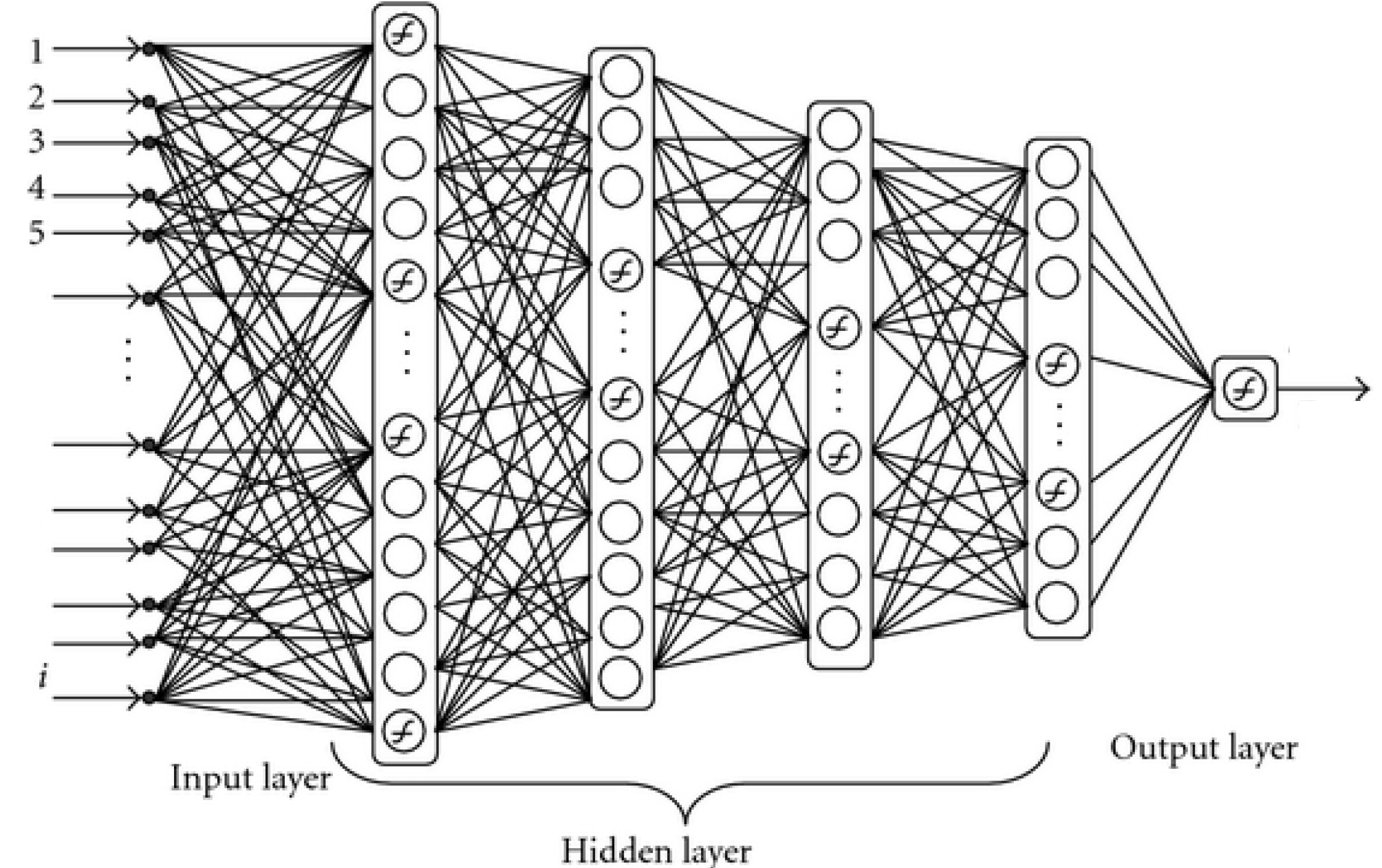
This is just a big complex model that computes $y = f(\mathbf x)$
Fundamental unit: artificial neuron¶
- input of some size
- weights
- Activation function
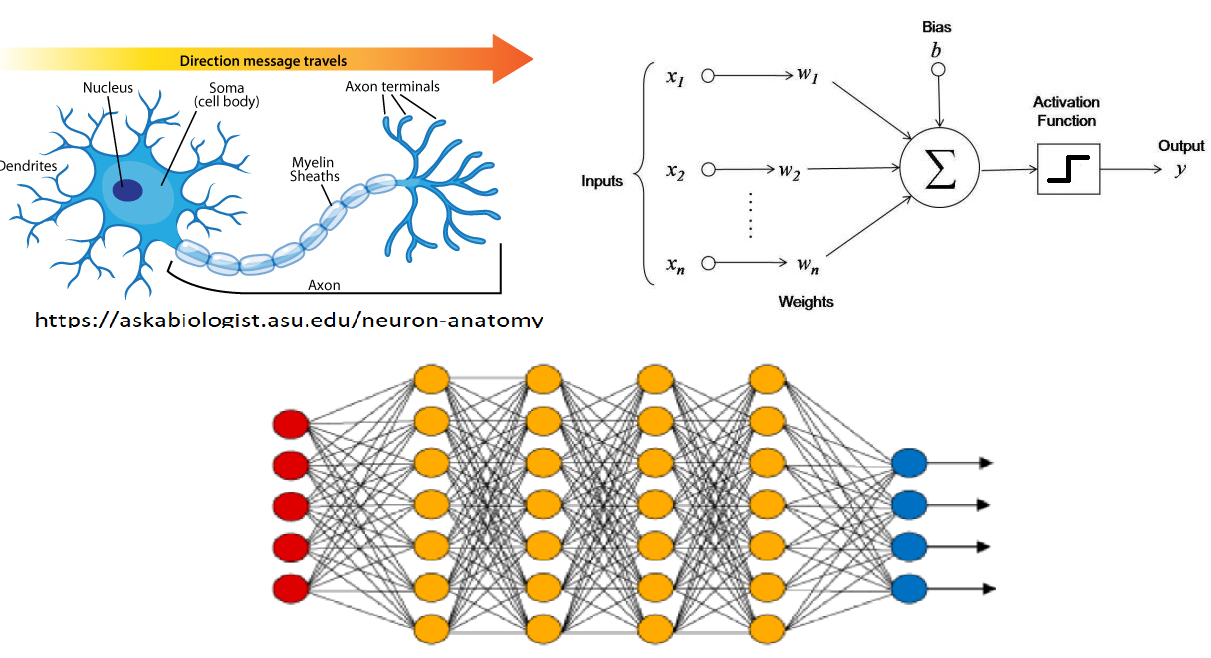
Operation
- computes a weighted sum of its inputs $z = w_1 x_1 + w_2 x_2 + ... + w_n x_n + b= \mathbf w^T \mathbf x +b$,
- then applies a step function to that sum and outputs the result: $h_{\mathbf w}(\mathbf x) = \sigma(z) = \sigma(\mathbf w^T \mathbf x +b)$
II. Keras¶
Fully-connected Layer¶
a.k.a. Densely-connected Layer - every input connects to every output (with weights)
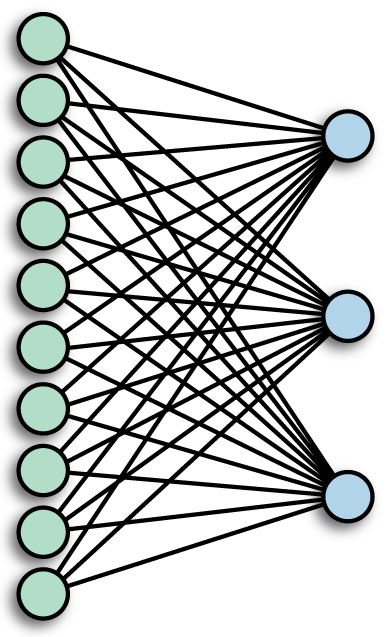
- Each node computes a weighted sum of all inputs $z_i = w_1 x_1 + w_2 x_2 + ... + w_n x_n + b_i= \mathbf w_i^T \mathbf x + \mathbf b$,
- Then applies a step function to that sum and outputs the result: $\mathbf h(\mathbf x) = \sigma(\mathbf z) = \sigma(\mathbf W^T \mathbf x + \mathbf b)$
Layers in Keras¶
Connection decisions: Fully-connected Layers, Convolutional Layers
Unified way to define other aspects of network: activation function, dropout, even pre-processing steps
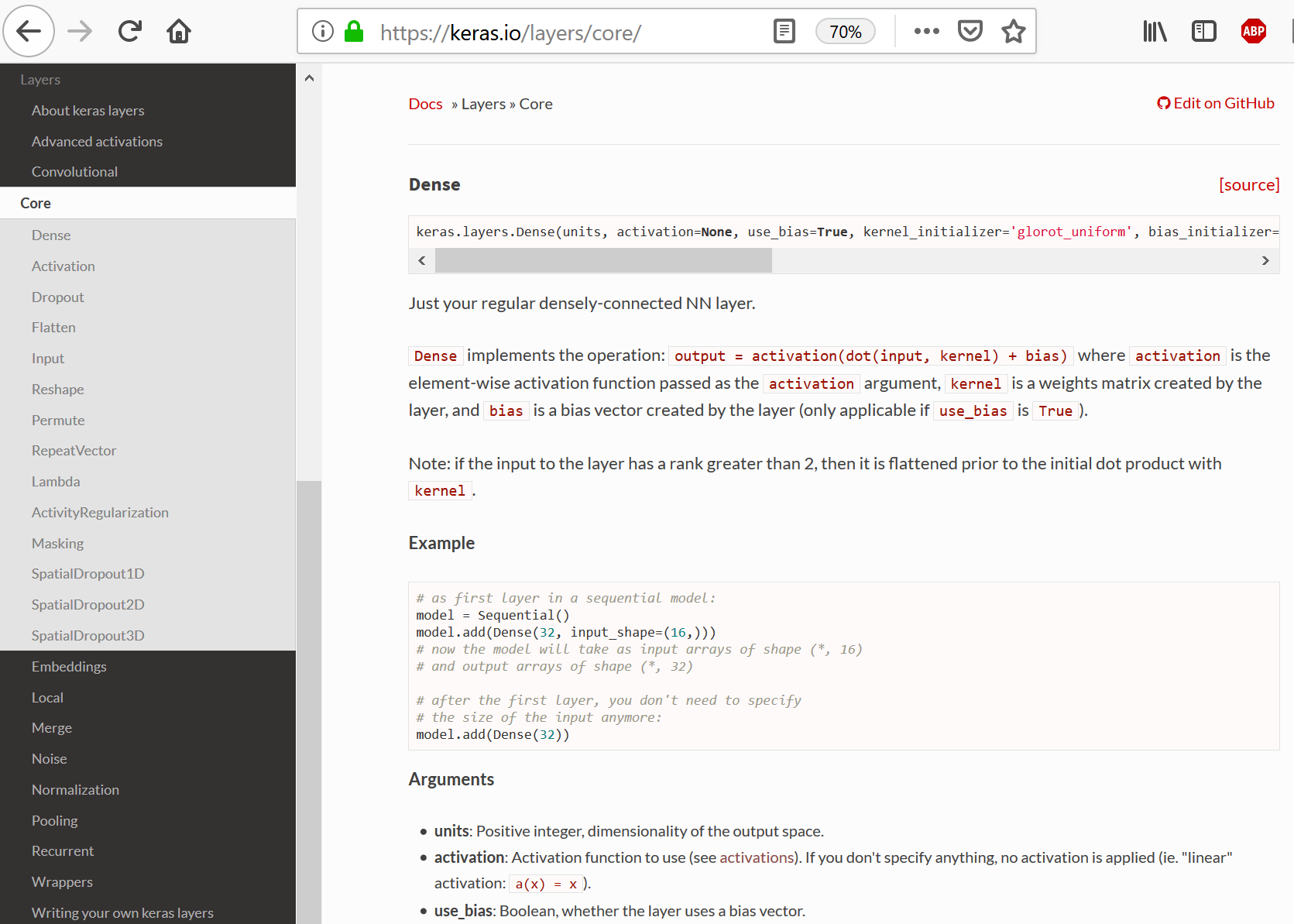
Deep Network Design¶
Make up an architecture - choose layers and their parameters
Choose a Loss function - how compute error for $f(\mathbf x_{(i)}) \ne y_i$
Choose a optimization method - many variants of same basic method
Choose "regularization" tricks to prevent overfitting
Other important details like initializing and normalizing data
Keras Embedding Layer¶
Literally download GloVe or word2vec and use .set_weights() to set it as weights
$$\mathbf h(\mathbf x) = \sigma(\mathbf z) = \sigma(\mathbf W^T \mathbf x + \mathbf b) = \mathbf E^T \mathbf x$$See Chollet Ch.6 for examples
from keras.models import Sequential
from keras.layers import Embedding, Flatten, Dense
model = Sequential()
model.add(Embedding(max_words, embedding_dim, input_length=maxlen))
model.add(Flatten())
model.add(Dense(32, activation='relu'))
model.add(Dense(1, activation='sigmoid'))
model.summary()
_________________________________________________________________ Layer (type) Output Shape Param # ================================================================= embedding_2 (Embedding) (None, 100, 100) 1000000 _________________________________________________________________ flatten_1 (Flatten) (None, 10000) 0 _________________________________________________________________ dense_1 (Dense) (None, 32) 320032 _________________________________________________________________ dense_2 (Dense) (None, 1) 33 ================================================================= Total params: 1,320,065 Trainable params: 1,320,065 Non-trainable params: 0 _________________________________________________________________
# Set embedding layer weights to GloVe matrix and freeze
model.layers[0].set_weights([embedding_matrix])
model.layers[0].trainable = False
Using a (fixed-length) sequence of words as inputs¶
Notice output shape was 3D, because each sample consisted of a list of words, each embedded to a vector
For each word in an input consisting of $$\mathbf h(\mathbf x) = \sigma(\mathbf z) = \sigma(\mathbf W^T \mathbf x + \mathbf b) = [\mathbf E^T \mathbf x^{(1)},\mathbf E^T \mathbf x^{(2)},...,\mathbf E^T \mathbf x^{(N)}]$$
"Flatten" layer converted this to a single concatenated vector
III. Keras Demo¶
Shallow network (logistic regression) IMDB demo¶
Tensorflow demo (with Keras): Text classification with preprocessed text - Movie reviews https://www.tensorflow.org/tutorials/keras/text_classification
Chollet has a similar model and notebook which attempts to use GloVe embeddings. Unfortunately it doesn't work.
Many more examples for Keras independently https://github.com/keras-team/keras/tree/master/examples
- $\mathbf x_i$ (samples) are encoded sequences (reviews)
- $y_i$ (targets) are review class (positive or negative)
- Goal is to train model to predict review from text
Imports¶
install tensorflow-datasets via conda
import numpy as np
import tensorflow as tf
import tensorflow_datasets as tfds
print("Version: ", tf.__version__)
print("Eager mode: ", tf.executing_eagerly())
Version: 2.0.0 Eager mode: True
IMDB dataset¶
- Has been "encoded" so that the reviews (sequences of words) have been converted to sequences of integers
- Each integer represents a specific word in a dictionary.
To encode your own text see the Loading text tutorial
(train_data, test_data), info = tfds.load(
'imdb_reviews/subwords8k', # Use the version pre-encoded with an ~8k vocabulary.
split = (tfds.Split.TRAIN, tfds.Split.TEST), # Return the train/test datasets as a tuple.
as_supervised=True, # Return (example, label) pairs from the dataset (instead of a dictionary).
with_info=True) # Also return the `info` structure.
WARNING:absl:Warning: Setting shuffle_files=True because split=TRAIN and shuffle_files=None. This behavior will be deprecated on 2019-08-06, at which point shuffle_files=False will be the default for all splits.
info
tfds.core.DatasetInfo(
name='imdb_reviews',
version=0.1.0,
description='Large Movie Review Dataset.
This is a dataset for binary sentiment classification containing substantially more data than previous benchmark datasets. We provide a set of 25,000 highly polar movie reviews for training, and 25,000 for testing. There is additional unlabeled data for use as well.',
urls=['http://ai.stanford.edu/~amaas/data/sentiment/'],
features=FeaturesDict({
'label': ClassLabel(shape=(), dtype=tf.int64, num_classes=2),
'text': Text(shape=(None,), dtype=tf.int64, encoder=<SubwordTextEncoder vocab_size=8185>),
}),
total_num_examples=100000,
splits={
'test': 25000,
'train': 25000,
'unsupervised': 50000,
},
supervised_keys=('text', 'label'),
citation="""@InProceedings{maas-EtAl:2011:ACL-HLT2011,
author = {Maas, Andrew L. and Daly, Raymond E. and Pham, Peter T. and Huang, Dan and Ng, Andrew Y. and Potts, Christopher},
title = {Learning Word Vectors for Sentiment Analysis},
booktitle = {Proceedings of the 49th Annual Meeting of the Association for Computational Linguistics: Human Language Technologies},
month = {June},
year = {2011},
address = {Portland, Oregon, USA},
publisher = {Association for Computational Linguistics},
pages = {142--150},
url = {http://www.aclweb.org/anthology/P11-1015}
}""",
redistribution_info=,
)
Encoder¶
The dataset info includes the text encoder (a tfds.features.text.SubwordTextEncoder).
encoder = info.features['text'].encoder
print ('Vocabulary size: {}'.format(encoder.vocab_size))
Vocabulary size: 8185
This text encoder will reversibly encode any string:
sample_string = 'Hello TensorFlow.'
encoded_string = encoder.encode(sample_string)
print ('Encoded string is {}'.format(encoded_string))
original_string = encoder.decode(encoded_string)
print ('The original string: "{}"'.format(original_string))
assert original_string == sample_string
Encoded string is [4025, 222, 6307, 2327, 4043, 2120, 7975] The original string: "Hello TensorFlow."
The encoder encodes the string by breaking it into subwords or characters if the word is not in its dictionary. So the more a string resembles the dataset, the shorter the encoded representation will be.
for ts in encoded_string:
print ('{} ----> {}'.format(ts, encoder.decode([ts])))
4025 ----> Hell 222 ----> o 6307 ----> Ten 2327 ----> sor 4043 ----> Fl 2120 ----> ow 7975 ----> .
Explore the data¶
- The dataset comes preprocessed: each example is an array of integers representing the words of the movie review.
- The text of reviews have been converted to integers, where each integer represents a specific word-piece in the dictionary.
- Each label is an integer value of either 0 or 1, where 0 is a negative review, and 1 is a positive review.
for train_example, train_label in train_data.take(1):
print('Encoded text:', train_example[:10].numpy())
print('Label:', train_label.numpy())
Encoded text: [2074 3705 154 533 1654 7 4 5993 11 25] Label: 0
The info structure contains the encoder/decoder. The encoder can be used to recover the original text:
encoder.decode(train_example)
"Grieving couple move to a cabin on a mountain after the loss of their daughter, discovering that there may be ghosts haunting the place, restless spirits of past occupants who committed suicide. Julie Pyke(Cheri Christian)blames husband Allen(Greg Thompson)for the horrible death of their daughter due to leaving the door unlocked and the marriage has deteriorated because of it. Julie remains in a zombie state, eliciting next to no emotion, remote and numb, only photographing a nearby abandoned prison, finding a startling image of a ghoul girl clinging to the bars of a cell. Though Allen doesn't see anything out of the ordinary, Julie continues to take pictures and we can recognize that something isn't quite right. A local handyman, Jim Payne(Scott Hodges), a rather distant fellow who harbors a secret becomes a dangerous threat when it is revealed that his dead mother might have something to do with the haunts occurring to the Pykes. Meanwhile the neighbors who sold the Pykes the cabin find themselves victims as well, alcoholic Mr Booth's abuse to his wife coming back to haunt him. Allen will conduct an investigation into the history of his cabin, attempting to unravel the mystery about the place.<br /><br />Plenty of ghosts moving about in the background in this somber supernatural tale with practically every character miserable. Cheri Christian remains so vacuous and lost, it's incredibly hard to connect with her despite the fact that you understand her plight. The acting, as is often mentioned, remains frustrating because none of the characters exactly are easy to latch on to. I guess it's supposed to be this way, under their circumstances, but the trouble I had was never being able to properly embrace the Pykes due to their constant state of aloofness. Cheri comes off as cold and detached, as I figure a mother would tend to be when you lose a child in such a way, but the icy nature left me pleading inside to embrace her which I just never could. I think the right performers, even if the characters are going through an emotional turmoil, can grab the hearts of their viewers, if a humanity reaches out to us..in this movie's case, the leads are unable to do so, for whatever reason. It could've been me, I don't know. I wanted to care for them, but nothing in the characters tugged on my heart strings. Anyway, as the film continues, Allen slowly uncovers certain truths and must defend himself against his wife who has convinced herself that their daughter is among them and she won't lose her little girl again. Jim, the unstable neighbor who believes that to stop the hauntings plaguing the area he must kill the Pykes, becomes a vital threat. The ghosts remain a central part of the movie, their presence, particularly Jim's mother, established throughout, off in the distance. The finale reveals all of them as Allen must find help for his wife while trying to thwart Jim's mission. I had a hard time getting into this one due to my unease with the leads and their characters."
Prepare the data for training¶
Create batches of training data for your model. The reviews are all different lengths, so use padded_batch to zero pad the sequences while batching
As of TensorFlow 2.2 the padded_shapes argument is no longer required. The default behavior is to pad all axes to the longest in the batch.
BUFFER_SIZE = 1000
train_batches = (
train_data
.shuffle(BUFFER_SIZE)
.padded_batch(32, padded_shapes=([None],[])))
test_batches = (
test_data
.padded_batch(32, padded_shapes=([None],[])))
Each batch will have a shape of (batch_size, sequence_length) because the padding is dynamic each batch will have a different length:
for example_batch, label_batch in train_batches.take(2):
print("Batch shape:", example_batch.shape)
print("label shape:", label_batch.shape)
Batch shape: (32, 1201) label shape: (32,) Batch shape: (32, 1130) label shape: (32,)
Build the model¶
The neural network is created by stacking layers—this requires two main architectural decisions:
- How many layers to use in the model?
- How many hidden units to use for each layer?
In this example, the input data consists of an array of word-indices. The labels to predict are either 0 or 1. Let's build a "Continuous bag of words" style model for this problem:
Caution: This model doesn't use masking, so the zero-padding is used as part of the input, so the padding length may affect the output. To fix this, see the masking and padding guide.
model = tf.keras.Sequential([
tf.keras.layers.Embedding(encoder.vocab_size, 16),
tf.keras.layers.GlobalAveragePooling1D(),
tf.keras.layers.Dense(1)])
model.summary()
Model: "sequential" _________________________________________________________________ Layer (type) Output Shape Param # ================================================================= embedding (Embedding) (None, None, 16) 130960 _________________________________________________________________ global_average_pooling1d (Gl (None, 16) 0 _________________________________________________________________ dense (Dense) (None, 1) 17 ================================================================= Total params: 130,977 Trainable params: 130,977 Non-trainable params: 0 _________________________________________________________________
The layers are stacked sequentially to build the classifier:¶
- The first layer is an
Embeddinglayer. This layer takes the integer-encoded vocabulary and looks up the embedding vector for each word-index. These vectors are learned as the model trains. The vectors add a dimension to the output array. The resulting dimensions are:(batch, sequence, embedding). - Next, a
GlobalAveragePooling1Dlayer returns a fixed-length output vector for each example by averaging over the sequence dimension. This allows the model to handle input of variable length, in the simplest way possible. - This fixed-length output vector is piped through a fully-connected (
Dense) layer with 16 hidden units. - The last layer is densely connected with a single output node. Using the
sigmoidactivation function, this value is a float between 0 and 1, representing a probability, or confidence level. For numerical stability, use thelinearactivation function that represents the logits.
Hidden units¶
The above model has two intermediate or "hidden" layers, between the input and output. The number of outputs (units, nodes, or neurons) is the dimension of the representational space for the layer. In other words, the amount of freedom the network is allowed when learning an internal representation.
If a model has more hidden units (a higher-dimensional representation space), and/or more layers, then the network can learn more complex representations. However, it makes the network more computationally expensive and may lead to learning unwanted patterns—patterns that improve performance on training data but not on the test data. This is called overfitting, and we'll explore it later.
Loss function and optimizer¶
A model needs a loss function and an optimizer for training. Since this is a binary classification problem and the model outputs a probability (a single-unit layer with a sigmoid activation), we'll use the binary_crossentropy loss function.
This isn't the only choice for a loss function, you could, for instance, choose mean_squared_error. But, generally, binary_crossentropy is better for dealing with probabilities—it measures the "distance" between probability distributions, or in our case, between the ground-truth distribution and the predictions.
Later, when we are exploring regression problems (say, to predict the price of a house), we will see how to use another loss function called mean squared error.
Now, configure the model to use an optimizer and a loss function:
model.compile(optimizer='adam',
loss=tf.losses.BinaryCrossentropy(from_logits=True),
metrics=['accuracy'])
Train the model¶
Train the model by passing the Dataset object to the model's fit function. Set the number of epochs.
history = model.fit(train_batches,
epochs=10,
validation_data=test_batches,
validation_steps=30)
Epoch 1/10 782/782 [==============================] - 11s 14ms/step - loss: 0.6832 - accuracy: 0.5007 - val_loss: 0.0000e+00 - val_accuracy: 0.0000e+00 Epoch 2/10 782/782 [==============================] - 8s 10ms/step - loss: 0.6257 - accuracy: 0.5485 - val_loss: 0.5967 - val_accuracy: 0.5729 Epoch 3/10 782/782 [==============================] - 8s 10ms/step - loss: 0.5454 - accuracy: 0.6587 - val_loss: 0.5300 - val_accuracy: 0.6781 Epoch 4/10 782/782 [==============================] - 8s 10ms/step - loss: 0.4791 - accuracy: 0.7456 - val_loss: 0.4764 - val_accuracy: 0.7552 Epoch 5/10 782/782 [==============================] - 8s 10ms/step - loss: 0.4234 - accuracy: 0.8017 - val_loss: 0.4356 - val_accuracy: 0.7698 Epoch 6/10 782/782 [==============================] - 8s 10ms/step - loss: 0.3841 - accuracy: 0.8298 - val_loss: 0.4031 - val_accuracy: 0.7958 Epoch 7/10 782/782 [==============================] - 8s 10ms/step - loss: 0.3512 - accuracy: 0.8505 - val_loss: 0.3776 - val_accuracy: 0.8271 Epoch 8/10 782/782 [==============================] - 8s 10ms/step - loss: 0.3262 - accuracy: 0.8649 - val_loss: 0.3573 - val_accuracy: 0.8438 Epoch 9/10 782/782 [==============================] - 8s 10ms/step - loss: 0.3051 - accuracy: 0.8767 - val_loss: 0.3435 - val_accuracy: 0.8323 Epoch 10/10 782/782 [==============================] - 8s 10ms/step - loss: 0.2874 - accuracy: 0.8854 - val_loss: 0.3344 - val_accuracy: 0.8229
Evaluate the model¶
And let's see how the model performs. Two values will be returned. Loss (a number which represents our error, lower values are better), and accuracy.
loss, accuracy = model.evaluate(test_batches)
print("Loss: ", loss)
print("Accuracy: ", accuracy)
782/782 [==============================] - 3s 4ms/step - loss: 0.3370 - accuracy: 0.8356 Loss: 0.3370138832446559 Accuracy: 0.83564
This fairly naive approach achieves an accuracy of about 87%. With more advanced approaches, the model should get closer to 95%.
Create a graph of accuracy and loss over time¶
model.fit() returns a History object that contains a dictionary with everything that happened during training:
history_dict = history.history
history_dict.keys()
dict_keys(['loss', 'accuracy', 'val_loss', 'val_accuracy'])
There are four entries: one for each monitored metric during training and validation. We can use these to plot the training and validation loss for comparison, as well as the training and validation accuracy:
import matplotlib.pyplot as plt
acc = history_dict['accuracy']
val_acc = history_dict['val_accuracy']
loss = history_dict['loss']
val_loss = history_dict['val_loss']
epochs = range(1, len(acc) + 1)
# "bo" is for "blue dot"
plt.plot(epochs, loss, 'bo', label='Training loss')
# b is for "solid blue line"
plt.plot(epochs, val_loss, 'b', label='Validation loss')
plt.title('Training and validation loss')
plt.xlabel('Epochs')
plt.ylabel('Loss')
plt.legend()
plt.show()
plt.clf() # clear figure
plt.plot(epochs, acc, 'bo', label='Training acc')
plt.plot(epochs, val_acc, 'b', label='Validation acc')
plt.title('Training and validation accuracy')
plt.xlabel('Epochs')
plt.ylabel('Accuracy')
plt.legend(loc='lower right')
plt.show()
In this plot, the dots represent the training loss and accuracy, and the solid lines are the validation loss and accuracy.
Notice the training loss decreases with each epoch and the training accuracy increases with each epoch. This is expected when using a gradient descent optimization—it should minimize the desired quantity on every iteration.
This isn't the case for the validation loss and accuracy—they seem to peak after about twenty epochs. This is an example of overfitting: the model performs better on the training data than it does on data it has never seen before. After this point, the model over-optimizes and learns representations specific to the training data that do not generalize to test data.
For this particular case, we could prevent overfitting by simply stopping the training after twenty or so epochs. Later, you'll see how to do this automatically with a callback.
IV. Convolutional Networks for NLP¶
Recall fully-connected a.k.a. Densely-connected a.k.a dense Layer¶

Implements $\sigma(\mathbf W^T \mathbf x + \mathbf b)$
Convolutional Layer¶
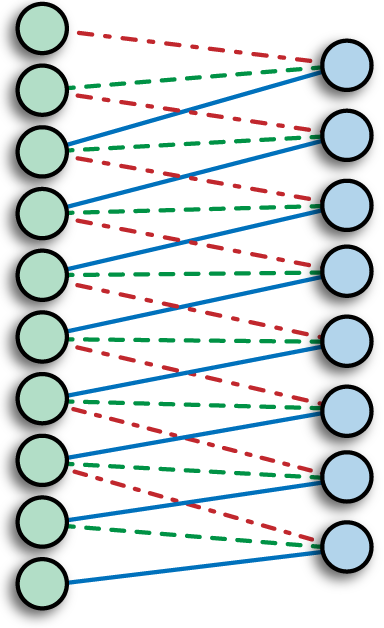
- Parameter sharing (same color = same weight)
- Far fewer weights to deal with versus dense layer.
Implements $\sigma(\mathbf W^T \mathbf x + \mathbf b)$ where $\mathbf W$ has a certain structure
Pooling Layer¶
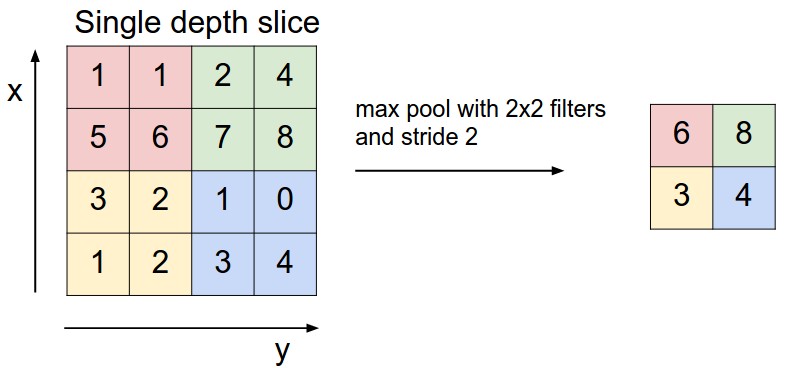
Convolutional neural networks (CNN) for Sequences¶
Dominant achitecture type for processing images
Not immediately obvious that would work well for text, but major advantages in efficiency and speed allow use of many layers and good performance when adapted for text processing
Kim 2014: treat text as a sequence of finite length
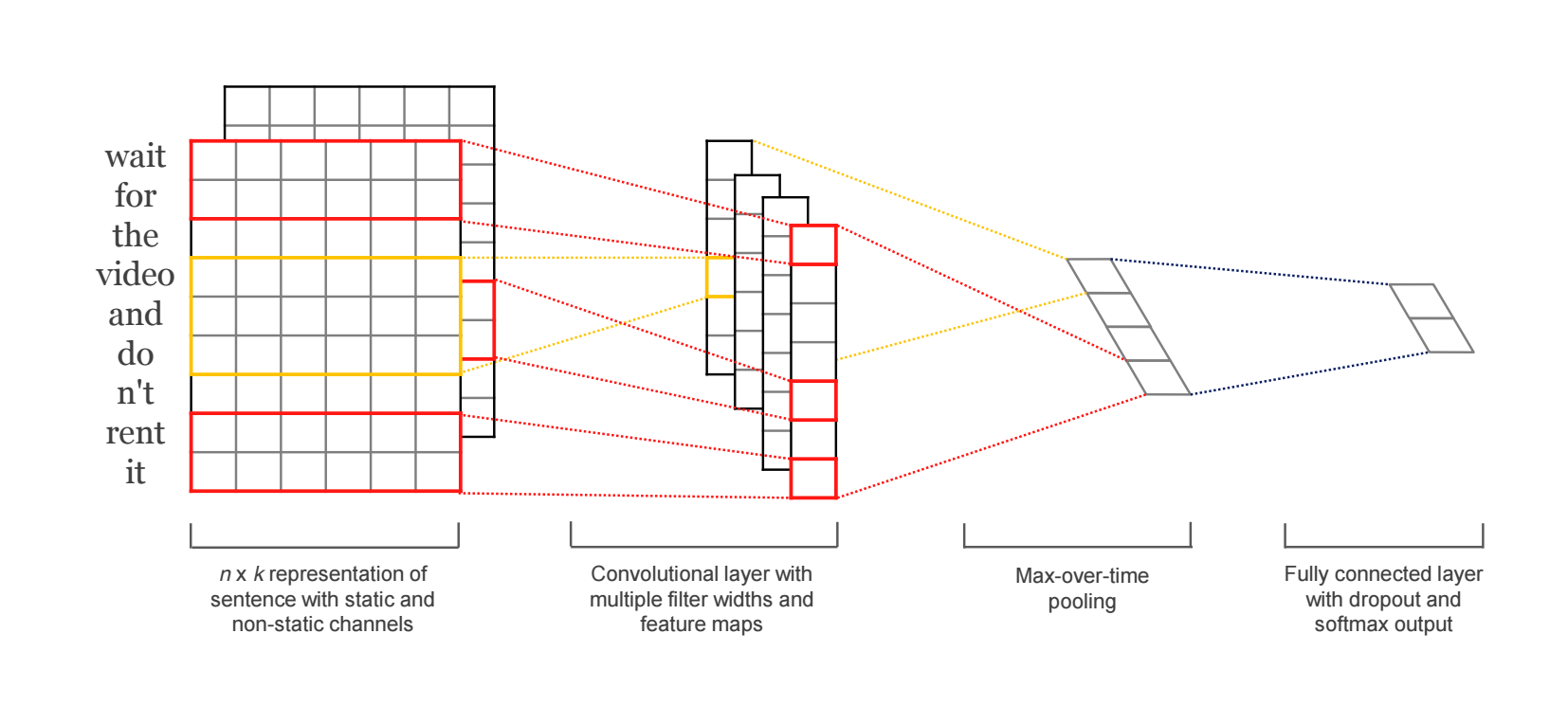
The next layer performs convolutions over the embedded word vectors using multiple filter sizes. For example, sliding over 3, 4 or 5 words at a time.
Next, the result of the convolutional layer is max-pooled into a long feature vector.
Create a classification prediction with a softmax layer.
import numpy as np
import tensorflow as tf
from tensorflow import keras
print("TF version: ", tf.__version__)
print("Keras version: ", keras.__version__)
TF version: 2.0.0 Keras version: 2.2.4-tf
from tensorflow.keras.datasets import imdb
max_features = 10000 # number of words to consider as features
max_len = 500 # cut texts after this number of words (among top max_features most common words)
print('Loading data...')
(x_train, y_train), (x_test, y_test) = imdb.load_data(num_words=max_features)
print(len(x_train), 'train sequences')
print(len(x_test), 'test sequences')
Loading data... 25000 train sequences 25000 test sequences
from tensorflow.keras.preprocessing import sequence
print('Pad sequences (samples x time)')
x_train = sequence.pad_sequences(x_train, maxlen=max_len)
x_test = sequence.pad_sequences(x_test, maxlen=max_len)
print('x_train shape:', x_train.shape)
print('x_test shape:', x_test.shape)
print('y_train shape:', y_train.shape)
print('y_test shape:', y_test.shape)
Pad sequences (samples x time) x_train shape: (25000, 500) x_test shape: (25000, 500) y_train shape: (25000,) y_test shape: (25000,)
from tensorflow.keras.models import Sequential
from tensorflow.keras import layers
model = Sequential()
model.add(layers.Embedding(max_features, 128, input_length=max_len))
model.add(layers.Conv1D(32, 7, activation='relu'))
model.add(layers.MaxPooling1D(5))
model.add(layers.Conv1D(32, 7, activation='relu'))
model.add(layers.GlobalMaxPooling1D())
model.add(layers.Dense(1))
model.summary()
Model: "sequential_10" _________________________________________________________________ Layer (type) Output Shape Param # ================================================================= embedding_5 (Embedding) (None, 500, 128) 1280000 _________________________________________________________________ conv1d_2 (Conv1D) (None, 494, 32) 28704 _________________________________________________________________ max_pooling1d_1 (MaxPooling1 (None, 98, 32) 0 _________________________________________________________________ conv1d_3 (Conv1D) (None, 92, 32) 7200 _________________________________________________________________ global_max_pooling1d_1 (Glob (None, 32) 0 _________________________________________________________________ dense_20 (Dense) (None, 1) 33 ================================================================= Total params: 1,315,937 Trainable params: 1,315,937 Non-trainable params: 0 _________________________________________________________________
model.compile(loss='binary_crossentropy',
metrics=['acc'])
history = model.fit(x_train, y_train,
epochs=10,
batch_size=128,
validation_split=0.2)
Train on 20000 samples, validate on 5000 samples Epoch 1/10 20000/20000 [==============================] - 38s 2ms/sample - loss: 0.6391 - acc: 0.6805 - val_loss: 0.4320 - val_acc: 0.8498 Epoch 2/10 20000/20000 [==============================] - 35s 2ms/sample - loss: 0.3795 - acc: 0.8826 - val_loss: 0.4221 - val_acc: 0.8764 Epoch 3/10 20000/20000 [==============================] - 35s 2ms/sample - loss: 0.3026 - acc: 0.9215 - val_loss: 0.7598 - val_acc: 0.8260 Epoch 4/10 20000/20000 [==============================] - 35s 2ms/sample - loss: 0.2410 - acc: 0.9485 - val_loss: 0.5943 - val_acc: 0.8710 Epoch 5/10 20000/20000 [==============================] - 34s 2ms/sample - loss: 0.1917 - acc: 0.9647 - val_loss: 1.7490 - val_acc: 0.7712 Epoch 6/10 20000/20000 [==============================] - 36s 2ms/sample - loss: 0.1539 - acc: 0.9786 - val_loss: 0.8288 - val_acc: 0.8768 Epoch 7/10 20000/20000 [==============================] - 36s 2ms/sample - loss: 0.1306 - acc: 0.9855 - val_loss: 0.9051 - val_acc: 0.8718 Epoch 8/10 20000/20000 [==============================] - 36s 2ms/sample - loss: 0.1192 - acc: 0.9895 - val_loss: 0.9541 - val_acc: 0.8722 Epoch 9/10 20000/20000 [==============================] - 34s 2ms/sample - loss: 0.1136 - acc: 0.9909 - val_loss: 1.0624 - val_acc: 0.8724 Epoch 10/10 20000/20000 [==============================] - 37s 2ms/sample - loss: 0.1112 - acc: 0.9908 - val_loss: 1.0685 - val_acc: 0.8754
acc = history.history['acc']
val_acc = history.history['val_acc']
loss = history.history['loss']
val_loss = history.history['val_loss']
epochs = range(len(acc))
plt.plot(epochs, acc, 'bo', label='Training acc')
plt.plot(epochs, val_acc, 'b', label='Validation acc')
plt.title('Training and validation accuracy')
plt.legend()
plt.figure()
plt.plot(epochs, loss, 'bo', label='Training loss')
plt.plot(epochs, val_loss, 'b', label='Validation loss')
plt.title('Training and validation loss')
plt.legend();
<matplotlib.legend.Legend at 0x7fdcee3f0d68>
